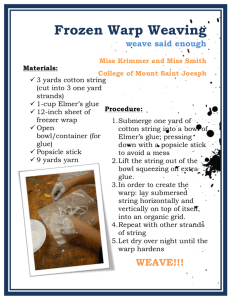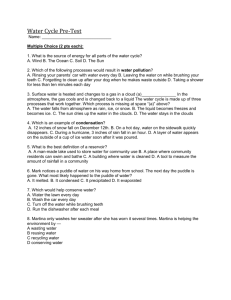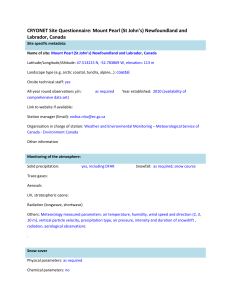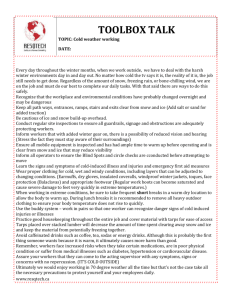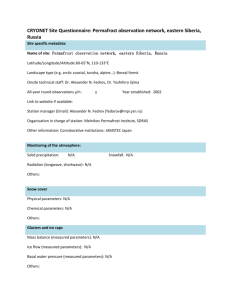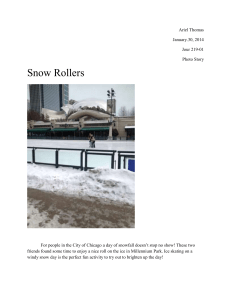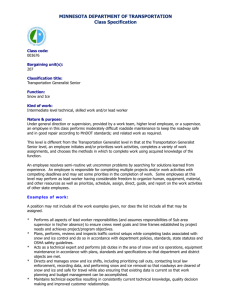January 2013 - Worcester`s Day of Play
advertisement
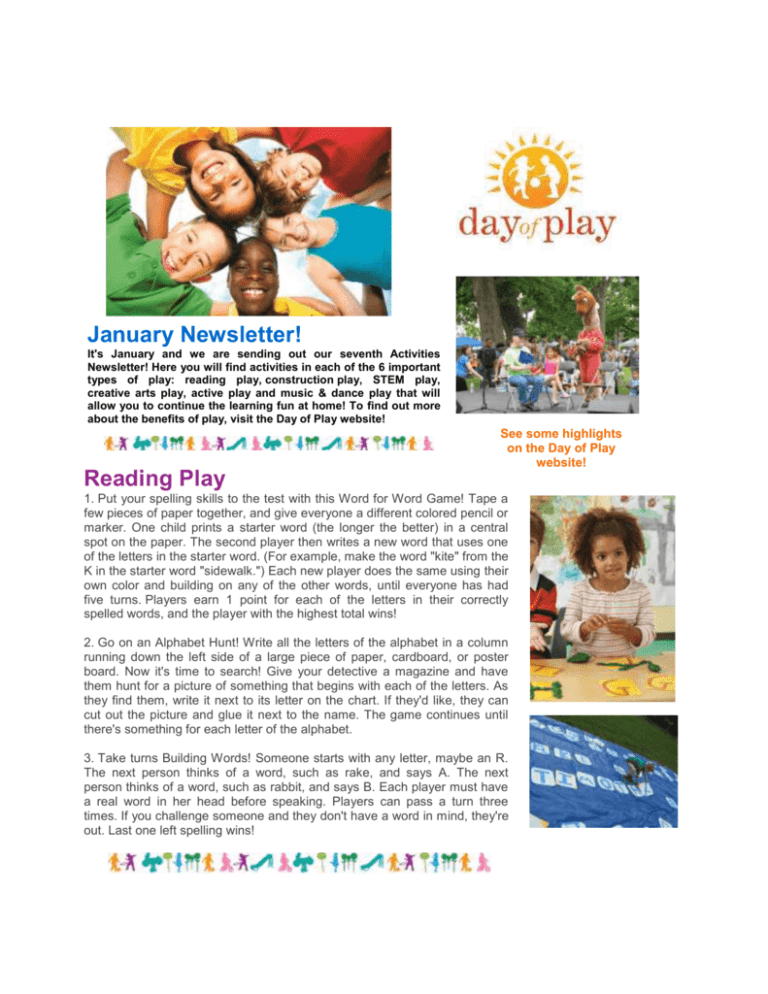
January Newsletter! It's January and we are sending out our seventh Activities Newsletter! Here you will find activities in each of the 6 important types of play: reading play, construction play, STEM play, creative arts play, active play and music & dance play that will allow you to continue the learning fun at home! To find out more about the benefits of play, visit the Day of Play website! Reading Play See some highlights on the Day of Play website! Reading Play 1. Put your spelling skills to the test with this Word for Word Game! Tape a few pieces of paper together, and give everyone a different colored pencil or marker. One child prints a starter word (the longer the better) in a central spot on the paper. The second player then writes a new word that uses one of the letters in the starter word. (For example, make the word "kite" from the K in the starter word "sidewalk.") Each new player does the same using their own color and building on any of the other words, until everyone has had five turns. Players earn 1 point for each of the letters in their correctly spelled words, and the player with the highest total wins! 2. Go on an Alphabet Hunt! Write all the letters of the alphabet in a column running down the left side of a large piece of paper, cardboard, or poster board. Now it's time to search! Give your detective a magazine and have them hunt for a picture of something that begins with each of the letters. As they find them, write it next to its letter on the chart. If they'd like, they can cut out the picture and glue it next to the name. The game continues until there's something for each letter of the alphabet. 3. Take turns Building Words! Someone starts with any letter, maybe an R. The next person thinks of a word, such as rake, and says A. The next person thinks of a word, such as rabbit, and says B. Each player must have a real word in her head before speaking. Players can pass a turn three times. If you challenge someone and they don't have a word in mind, they're out. Last one left spelling wins! Construction Play 1. Build a Castle Recycled Objects Castle! Sort all of the household recycling into categories. Make a pile for cylinders, cones, cubes, and so on. Use a box lid as a building platform, and start gluing and taping down the main shapes for the foundation of the castle. As you go, invite your child to make connections: what shapes make up castles? How do they stay up without toppling? Notes: milk cartons come with "peaked roofs" already in place, and you can easily use straws to mount aluminum foil "flags". Paper towel rolls can be topped by cones or paper cups. String and spare pieces of cardboard can be used for drawbridges. When all the pieces are glued in place, paint the castle in any color they like. And add any details when the paint dries. 2. Make a Milk Carton Train! Cover the milk carton (including the triangular top part) with construction paper. Have your child cut out construction paper for the train's wheels. And use a toilet paper tube for the smokestack and glue them in the appropriate place. For reference, the pointed part of the milk carton will be the front of the train. Have them use markers or any other materials to add details on their train. When they're finished decorating, tape a piece of string to the front of the train so they can pull it along behind them and your child can turn the living room into their very own train station. All aboard! 3. Go boating with Plastic Bottle Boats! Start with two empty water or soda bottles with caps. If your child wants to add design to the boat, use colored permanent markers. With a marker, outline a 2" x 5" area that you will cut out of the bottle. Make sure the doll or toy fits in the opening. To cut, remove the caps and hold the bottle on a flat surface; using a knife, poke a hole through the center of the area you will cut, insert the scissors and make your larger cut. Don't forget to replace the cap, or the boat will sink! Tape the two bottles together with duct tape, running one strip around the bases of the bottles and another closer to the top. Fill a basin or bathtub several inches deep with water and let the fun begin! STEM Play (Science, Technology, Engineering and Math) 1. Try lifting an Ice Cube with a Piece of String! Submerge an ice cube in a glass of water for a second or two. Let it float to the top. Place one end of a length of string on top of the ice cube and try to pick it up (they will not be able to but that's part of the experiment!) Next, sprinkle a little salt over it and count to 5. Pick up the loose end of the string and the ice will lift right out of the glass! How does this work? Salt lowers the freezing temperature of water so it easily melts ice. That's why people spread it on the road when it snows, and why the ocean rarely freezes. When you sprinkle the salt on the ice, some of the ice melts back into water, which is absorbed by the string. Seconds later, the water in the string refreezes and the string is frozen to the cube, so you can pick it up! 2. Conduct a Polar Plunge experiment! Talk about how animals stay warm in the winter because of their extra layer of blubber. Then test how well your child is prepared to cope with the cold. Get a bowl or cup of ice water and have your child stick their finger in it and talk about what it feels like. Then, cover your child's finger in a layer of vegetable shortening and have them put their hand back in the ice water and talk about how it feels. Explain to them that the reason why their finger isn't cold is because, like blubber, the shortening helps hold in their body heat. 3. Do Celery Stick Science! Fill a tall, clear glass or jar half-full with water. Add a few drops of red food coloring and mix well. Trim the bottom of a large stalk of celery, leaving the leaves on the stalk. Place the celery stalk in the glass or jar and leave it overnight in order for the stalk to "drink" the water. Divide a sheet of paper horizontally into two sections labeled "before" and "after." Have your child draw a picture of the celery stalk "before" it drinks the red water and write or dictate a sentence or two about what they see. The next morning, observe what has happened. Let your child tell you where they think the water has gone and what has happened to the celery. (The water has been absorbed into the celery stalk, tinting the stem and leaves red.) Have your child complete the "after" portion of the observation sheet. Creative Arts Play 1. Make Egg Carton Goggles! Remove the lid from the egg carton, and cut a 2 cup strip from the bottom. The two wells will form the goggles or mask. Set aside the rest of the egg carton for another project (or more masks!). Trim any extra cardboard from the sides of the cups so they are perfectly round. Now cut out the bottom of the cups for the eye holes. Decorate the goggles with anything you like! When it's ready poke a hole on either side of the cups and tie a length of ribbon or string to each side. Have your child hold the goggles to their face and tie the ribbons together! 2. Create a Cereal Box Puzzle! Cut off front panel of the box and use a ruler and permanent marker to draw puzzle pieces on the backside, (remember to make two connecting tabs on each individual piece), and cut them out. Once all the pieces are cut out, lay them on the table and challenge your child to put it back together. Later you can make a puzzle for all of their favorite cereal or crackers! 3. Make your own Snow Paint! Measure equal parts white glue and shaving cream into a bowl or on a plate, mix them together and the snow paint is ready! It should be very thick and fluffy. Hand your child paper and a paintbrush and they are ready to create a snow scene. Use generous amounts of paint to create a three-dimensional effect. As they paint, talk about snow. When does it snow? What does it feel like? As the paint dries, it will harden and the shapes will remain. Your child will love touching their 3D snow painting. Active Play 1. Play the Jump Counting Game! First you'll need to create a set of Challenge Cards. You can draw your own pictures or cut out pictures of household objects and items from magazines. You can include any objects you want, such as: a door, window, table, book, desk, bed, couch, closet, circle, square, rectangle, triangle, chair, computer, and oven. Then start! When it's your turn; you pick a card and look at the picture. Then you say the name of the object out loud and estimates how many jumps it will take to get to it. For example, "A door. I can jump to it in 10 jumps" or "It's a circle. I can jump to that circle shaped table in 15 jumps". If they do it in the amount of jumps predicted, they keep the card. If not, it goes into the discard pile. Then it's the next player's turn. 2. Play Fox and Geese! This game requires four or more players and a large, open area of unspoiled snow. Stomp a big circle in the snow with two intersecting paths through the middle of it. Where the paths meet, stomp out a small safe zone. Choose one person to be the fox; all other players are geese. The fox chases the geese and tries to tag them. All players must run only on the paths, and geese can't be tagged when they're standing in the safe zone. As soon as the fox catches a goose, that goose becomes the new fox. 3. Start the Penguin Games! Lay out 4 to 6 pillows on a carpeted floor in a single file line. Have everyone line up and take turns hopping from pillow to pillow. They must land with both feet on a piece of ice; if they don't, they are considered to have fallen in the water and are out. Space the pillows a little farther apart for each round until all but one penguin, the winner, has been eliminated. Music & Dance Play 1. Make a Kazoo! Punch a hole in the side of the empty toilet paper roll as far from the end as the punch will reach. Cut a square of paper large enough to cover one end of the roll and glue it to one edge of the roll. Leave the roll standing on the paper until the glue is completely dry. If you like, your child can decorate their kazoo with crayons, markers, or stickers. To play the kazoo, show your child how to put their mouth against the open end of the kazoo and hum. 2. Break out the Crazy Walks! Walk slowly around the room using music to set the pace. Call out a movement such as forward, backward, sideways, little steps, giant steps, like a cat, like an elephant, etc., and have the kids respond as quickly as possible. Add to the activity by trying music with different tempos, moving from room to room and letting your child call out the directions. 3. Roll us a Song! Help your child draw six pictures representing their favorite songs. Glue or tape each picture to one side of a tissue box. Let your child roll the song block to choose what song to sing next! (ABC, Itsy-Bitsy Spider, Twinkle Twinkle Little Star, etc)
